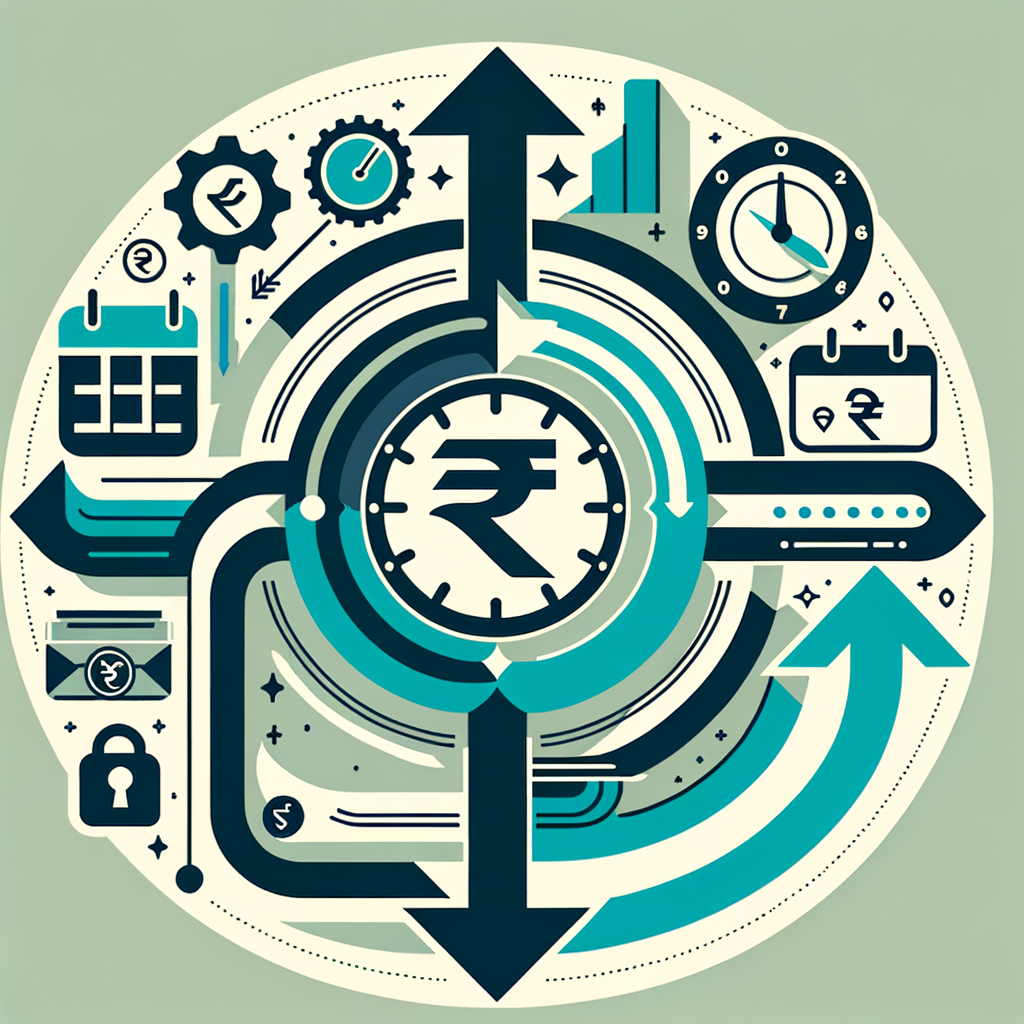Setting Up Automatic Payments to Stay on Track with Your Debt
That recurring feeling of dread as the first week of the month approaches is all too familiar for many of us. Juggling due dates for home loans, car EMIs, credit card bills, and business loans can feel like a high-stakes financial circus act. The constant fear of missing a single payment can be overwhelming. But what if there was a way to automate this entire process and reclaim your peace of mind? This is where mastering automatic payments tracking debt becomes a game-changer. By setting up automated debits, you transform debt management from a monthly chore into a seamless, background process, ensuring you stay on track with debt payments in India without the constant stress.
This comprehensive guide is designed for both salaried individuals and small business owners in India. We will walk you through everything you need to know about using automatic payments to manage your financial obligations effectively. From understanding the core benefits to a step-by-step setup process, you’ll learn how to leverage this simple tool to avoid late fees, boost your CIBIL score, and achieve greater financial discipline for both your personal and business health.
Why Proactive Debt Management is Non-Negotiable
Before diving into the “how-to,” it’s crucial to understand why timely debt repayment isn’t just a good habit—it’s a financial necessity. Ignoring or delaying payments can have severe and lasting consequences that go far beyond a simple reminder call from your bank. For both individuals and businesses, proactive management is the foundation of long-term financial stability.
The High Cost of Missed Payments
The most immediate consequence of missing a due date is financial. Lenders impose hefty late payment fees, which can add a significant amount to your outstanding balance. On top of this, you’ll be charged penalty interest on the overdue amount, which is often much higher than your regular interest rate. But the long-term damage is even more severe. Every missed payment is reported to credit bureaus like CIBIL, causing a significant drop in your credit score. A low CIBIL score can cripple your financial future, making it incredibly difficult to get approved for new loans, credit cards, or even rental agreements. When you are approved, you’ll likely face much higher interest rates, costing you thousands or even lakhs over the life of the loan.
The Vicious Cycle of Debt
A single missed payment can quickly snowball into a much larger problem. The added fees and penalty interest increase your total outstanding balance, making the next payment even harder to meet. This can trigger a vicious cycle where you’re constantly playing catch-up, with interest charges accumulating faster than you can pay them down. This scenario is a common and stressful challenge for individuals managing multiple EMIs and is particularly dangerous for small businesses that rely on stable cash flow to manage operational loans and vendor payments. Learning about Managing Cash Flow Effectively During Tax Season can provide crucial insights for business owners. Breaking this cycle requires discipline and a smart strategy, which is precisely where automation comes in.
The Core Benefits of Automatic Payments for Debt
Adopting an automated approach to your repayments isn’t just about convenience; it’s a strategic move to secure your financial well-being. By letting technology handle the logistics, you unlock several powerful benefits that simplify your life and strengthen your financial position.
Achieve “Set It and Forget It” Peace of Mind
The single greatest advantage of automation is the elimination of mental clutter. You no longer have to track multiple due dates in a calendar or worry about logging in to different portals to make payments. Once set up, the funds are debited on a pre-scheduled date every month without any manual intervention. This “set it and forget it” approach frees up your mental energy to focus on more important things, like growing your business or planning your investments. This is the essence of managing debt through automatic payments—it removes the human error factor and reduces financial anxiety.
Safeguard Your CIBIL Score
Your payment history is the single most important factor determining your CIBIL score, accounting for roughly 35% of the calculation. Learning How to Track Your Credit History Using Your PAN Card Via CIBIL is a key step in taking control. A consistent record of on-time payments is the best way to build and maintain a high score. Automatic payments ensure you never miss a due date due to oversight, creating a flawless repayment history over time. This positive record signals to lenders that you are a reliable borrower, significantly improving your creditworthiness for future financial needs.
Avoid Unnecessary Fees and Penalties
Late payment fees and penalty interest are essentially money down the drain. While a single late fee of ₹500 to ₹1,000 might seem manageable, these charges can add up significantly across multiple accounts over a year. By automating your payments, you ensure every bill is paid on time, completely eliminating these avoidable costs. The money you save can be redirected towards more productive uses, such as making an extra principal payment to clear your debt faster or investing for your future goals.
Simplify Your Financial Life
Automation brings clarity and predictability to your finances. Knowing exactly when and how much money will be debited from your account each month makes budgeting and cash flow management significantly easier. For small business owners juggling payments to multiple vendors, lenders, and for statutory dues, this simplification is invaluable. It streamlines the accounting process, provides a clear picture of monthly fixed outflows, and helps maintain a healthy financial rhythm for the business.
A Step-by-Step Guide to Automatic Payment Setup for Repayments in India
Setting up automatic payments is a straightforward process in India, thanks to a robust digital banking infrastructure. Follow these steps to take control of your debt repayments.
Step 1: Audit and Organize Your Debts
Before you can automate, you need a clear picture of what you owe. Create a simple spreadsheet or use a notebook to list all your outstanding debts. This will be your master sheet for tracking your liabilities.
| Creditor Name | Type of Debt | Outstanding Amount | Minimum Payment (EMI) | Interest Rate | Due Date |
|---|---|---|---|---|---|
| HDFC Bank | Home Loan | ₹25,00,000 | ₹22,500 | 8.5% | 5th of Month |
| SBI Card | Credit Card | ₹45,000 | ₹2,250 | 42% (p.a.) | 15th of Month |
| Bajaj Finserv | Personal Loan | ₹2,00,000 | ₹9,500 | 14% | 10th of Month |
Step 2: Understand the Mechanisms in India
In India, several systems facilitate automatic payments. Understanding them will help you choose the right one for your needs.
- NACH/e-Mandate: The National Automated Clearing House (NACH) is the most common system used by banks, NBFCs, and financial institutions for recurring payments like loan EMIs and insurance premiums. When you take out a loan, you typically sign a physical or digital (e-Mandate) form authorizing the lender to pull a fixed amount from your bank account on a specific date each month. It’s a highly reliable “pull-based” system.
- UPI Autopay: A feature built on the popular UPI platform, Autopay is perfect for recurring payments of smaller values, such as credit card bills, mobile recharges, or OTT subscriptions. You can set up a mandate for payments up to ₹15,000 per transaction (this limit is subject to change by the RBI). For more details, you can visit the NPCI’s official page on UPI Autopay.
- Bank Standing Instructions (SI): This is a directive you give to your own bank to transfer a fixed amount of money to another account on a regular basis. It’s ideal for payments like rent, transferring money to your parents, or moving funds into a recurring deposit. It’s a “push-based” system controlled entirely by you through your net banking portal.
Step 3: Setting Up a Mandate via Net Banking (Example)
Setting up auto-debit for a credit card bill or another loan is simple through your bank’s net banking portal. Here’s a generic walkthrough:
- Log In: Access your primary bank account’s net banking portal or mobile app.
- Navigate to Payments: Look for a section named “Bill Pay,” “Payments & Transfers,” or “Mandates.”
- Add a New Biller: Select the option to “Add a Biller” or “Register a Biller.” Choose the category (e.g., Credit Card, Loan, Insurance) and select the lender’s name from the list (e.g., ICICI Bank Credit Card, Tata Capital).
- Enter Details: You will be prompted to enter your unique identifier, such as your 16-digit credit card number or your loan account number.
- Set Up Auto Pay: Once the biller is added, find the “Auto Pay,” “Auto Debit,” or “Set Mandate” option. Here, you will define the payment parameters. For credit cards, you’ll see options for “Minimum Amount Due” or “Total Amount Due”. Always choose “Total Amount Due” to avoid interest charges.
- Authenticate: Review the details and confirm the setup by entering the One-Time Password (OTP) sent to your registered mobile number. Your automatic payment is now active.
Pro Tips for Automatic Payments in India
While automation is powerful, it’s not a magic wand. To make it work flawlessly, you need to manage the process wisely. Here are some essential tips for using automatic payments in India.
Maintain a Buffer Balance
This is the golden rule of automation. Always ensure your bank account has sufficient funds to cover the upcoming debits. It’s a good practice to maintain a buffer amount, equivalent to at least one month’s total EMIs, in your account at all times. An automatic payment that fails due to insufficient funds leads to NACH/ECS bounce charges from your bank (typically ranging from ₹250 to ₹750) and a late fee from your lender. This double penalty makes a failed payment very costly.
Enable Transaction Alerts
Knowledge is power. Make sure you have enabled SMS and email alerts from your bank for all transactions. This will notify you immediately when an auto-debit is successful or, more importantly, if it fails. A prompt alert about a failed payment gives you a chance to rectify the situation quickly by making a manual payment, potentially avoiding a negative report to CIBIL. This is a critical component of automatic payments tracking debt.
Schedule Payments Strategically
Align your payment dates with your cash flow. If your salary is credited on the 30th or 31st of the month, schedule your EMIs and other auto-debits for the 2nd or 3rd of the following month. This simple scheduling trick ensures that your account is always funded before the payment is due, dramatically reducing the risk of a bounce.
Conduct a Quarterly Review
“Set it and forget it” doesn’t mean “set it and ignore it.” Once every quarter, take 15 minutes to log in to your net banking portal and review all your active mandates and standing instructions. Check if the amounts are still correct and if all mandates are still necessary. This helps you catch any discrepancies, cancel payments for services you no longer use, and stay in complete control of your automated financial life.
Advanced Debt Repayment Strategies with Automatic Payments
Once you’ve automated your minimum payments, you can leverage the same system to accelerate your journey to becoming debt-free. For a detailed comparison of popular approaches, you can explore Debt Snowball vs. Debt Avalanche: Which Strategy Is Best for You?. Here are two popular strategies that work perfectly with automation.
The Debt Snowball Method
This method focuses on building momentum and motivation. It’s a great psychological boost for those who feel overwhelmed by debt.
- List Your Debts: Arrange all your debts from the smallest outstanding balance to the largest, regardless of the interest rate.
- Automate Minimums: Set up automatic payments for the minimum amount due on all your debts.
- Attack the Smallest: Allocate any extra money you have in your budget towards the smallest debt. You can set this up as an additional automatic transfer or make a manual payment.
- Roll It Over: Once the smallest debt is paid off, “roll over” the entire amount you were paying for it (minimum payment + extra payment) and add it to the minimum payment of the next-smallest debt.
- Repeat: Continue this process, creating a “snowball” of payment that knocks out your debts one by one.
The Debt Avalanche Method
This method is mathematically superior, as it saves you the most money on interest over time. It requires more discipline but delivers better financial results.
- List Your Debts: Arrange all your debts from the highest interest rate to the lowest, regardless of the balance. Credit card debt is often at the top of this list.
- Automate Minimums: Set up automatic payments for the minimum amount due on all your debts.
- Attack the Highest Interest: Direct all your extra funds towards the debt with the highest interest rate.
- Roll It Over: Once that debt is cleared, take the entire payment amount and add it to the minimum payment of the debt with the next-highest interest rate.
- Repeat: Continue this process until all your debts are paid off.
Conclusion
Making the shift from stressful manual tracking to a streamlined system of automatic payments tracking debt is one of the most powerful steps you can take toward financial stability and peace of mind. For busy salaried individuals and small business owners in India, this strategy is not a luxury—it’s a necessity. By embracing automation, you safeguard your CIBIL score, eliminate wasteful late fees, simplify your financial management, and build a disciplined foundation for your future. The journey begins with a single step. Take 30 minutes today to audit your debts and set up just one automatic payment. You’ll be amazed at how much lighter you feel.
While managing personal debt is a personal journey, ensuring your business finances are in order is where experts can help. If you’re a small business owner looking to streamline your accounting, GST, and overall financial health, contact TaxRobo for a consultation today.
FAQ Section
Q1: What happens if an automatic payment fails in India due to insufficient funds?
Answer: If an automatic payment fails, you face a double penalty. First, your bank will charge you an “ECS/NACH bounce penalty,” which can range from ₹250 to ₹750 per failed transaction. Second, your lender (e.g., loan provider or credit card company) will levy a “late payment fee” and may also charge additional penalty interest. Most importantly, the lender will report the missed payment to credit bureaus like CIBIL, which will negatively impact your credit score.
Q2: Can I set up automatic payments for my credit card bills?
Answer: Yes, absolutely. When setting up autopay for your credit card, you will typically be given two choices: automate the “Minimum Amount Due” (MAD) or the “Total Amount Due” (TAD). It is highly recommended to always automate the “Total Amount Due.” Paying only the minimum amount will cause the remaining balance to accrue interest at a very high rate (often 35-45% annually), trapping you in a cycle of debt.
Q3: How do I cancel an e-Mandate or automatic payment?
Answer: You can usually cancel an active mandate through your bank’s net banking portal, where you first set it up. Look for a section titled “My Mandates,” “Biller Management,” or “Scheduled Payments.” Select the mandate you wish to cancel and follow the on-screen instructions. It’s also a good practice to inform the biller/lender that you have cancelled the mandate on your end. Note that the cancellation process can take a few business days to be fully effective.
Q4: Is it safe to use UPI Autopay for loan repayments?
Answer: Yes, UPI Autopay is a very secure platform developed and managed by the National Payments Corporation of India (NPCI), under the regulation of the RBI. Every mandate you create requires authentication with your secure UPI PIN, giving you full control. It is a safe, fast, and convenient method for managing recurring payments, especially for smaller EMIs and other regular bills. For more information, you can always refer to the official security guidelines provided by NPCI.



